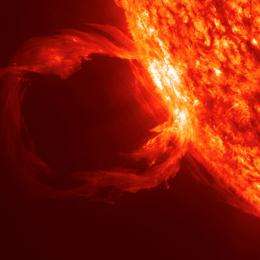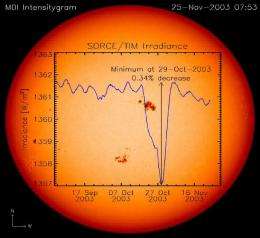Why NASA Keeps a Close Eye on the Sun's Irradiance

(PhysOrg.com) -- For more than two centuries, scientists have wondered how much heat and light the sun expels, and whether this energy varies enough to change Earth’s climate. In the absence of a good method for measuring the sun's output, the scientific conversation was often heavy with speculation.
By 1976, that began to change when Jack Eddy, a solar astronomer from Boulder, Colo., examined historical records of sunspots and published a seminal paper that showed some century-long variations in solar activity are connected with major climatic shifts. Eddy helped show that an extended lull in solar activity during the 17th Century --called the Maunder Minimum -- was likely connected to a decades-long cold period on Earth called the "Little Ice Age."
Two years after Eddy published his paper, NASA launched the first in a series of satellite instruments called radiometers, which measure the amount of sunlight striking the top of Earth's atmosphere, or total solar irradiance. Radiometers have provided unparalleled details about how the sun's irradiance has varied in the decades since. Such measurements have helped validate and expand upon Eddy's findings. And they've led to a number of other discoveries—and questions—about the sun.
Without radiometers, scientists would probably still wonder how much energy the sun emits and whether it varies with the sunspot cycle. They wouldn't know of the competition between dark sunspots and bright spots called faculae that drives irradiance variations.
And they’d have little chance of answering a question that continues to perplex solar experts today: Has overall irradiance changed progressively throughout the past three 11-year cycles, or are variations in the sun's irradiance limited to a single cycle?
The answer has important implications for understanding climate change, as some scientists have suggested that trends in solar irradiance account for a significant portion of global warming.
The next space radiometer, slated for launch this November aboard NASA's Glory satellite, should help chip away at the uncertainty that surrounding the sun's role in climate change.
A Variable Sun It's well known today that the sun's irradiance fluctuates constantly in conjunction with sunspots, which become more and less abundant every 11 years due to turbulent magnetic fields that course through the sun's interior and erupt onto its surface.
But as recently as the 1970s, scientists assumed that the sun’s irradiance was unchanging; the amount of energy it expels was even called the "solar constant."
It was data from radiometers aboard Nimbus 7, launched in 1978, and the Solar Maximum Mission, launched two years later, that were the death knell to the solar constant. Soon after launching, instruments aboard both satellites showed that solar irradiance changed significantly as patches of sunspots rotated around the sun's surface. Irradiance would fall, for example, when groups of sunspots faced Earth. And it would recover when the sunspots rotated to the far side of the sun.
Likewise, in 2003, a radiometer aboard NASA's Solar Radiation and Climate Experiment (SORCE) satellite observed large sunspot patches that caused irradiance to drop by as much 0.34 percent, the largest short-term decrease ever recorded.
"When you look at longer scales on the sun, it's the opposite," said Lean, a solar scientist at the U.S. Naval Research Laboratory in Washington, D.C., and a member of Glory's science team. "Overall, irradiance actually increases when the sun is more active even though sunspots are more common."
How can increases in dark, cool sunspots yield increases in irradiance? "It didn't make much sense until we were able to show that sunspots are just half of the story," said Lean.
Measurements collected during the 1980s and 1990s gave scientists the evidence they needed to prove that irradiance is actually a balance between darkening from sunspots and brightening from accompanying hot regions called faculae, a word meaning "bright torch" in Latin.
When solar activity increases, as it does every 11 years or so, both sunspots and faculae become more numerous. But during the peak of a cycle, the faculae brighten the sun more than sunspots dim it.
Overall, radiometers show that the sun’s irradiance changes by about 0.1 percent as the number of sunspots varies from about 20 sunspots or less per year during periods of low activity (solar minimum) to between 100 and 150 during periods of high activity (solar maximum).

“That may seem like a tiny amount, but it’s critical we understand even these small changes if we want to understand whether the sun's output is trending up or down and affecting climate,” said Greg Kopp, a principal investigator for Glory and scientist at the Laboratory for Atmospheric and Space Physics at the University of Colorado in Boulder.
Though most scientists believe the 0.1 percent variation is too subtle to explain all of the recent warming, it's not impossible that long-term patterns -- proceeding over hundreds or thousands of years -- could cause more severe swings that could have profound impacts on climate.
Searching for a Trend Line
A total of 10 radiometers have monitored the sun since Nimbus 7, and by patching all of the measurements together into one data stream, scientists have tried to identify whether the sun’s irradiance has increased or decreased over the last three cycles.
However, melding the results from different instruments has proven complicated because many of the radiometers record slightly different absolute measurements. And the areas of overlap between instruments in the long-term record aren't as robust as scientists would like.
As a result, questions remain about how the sun's irradiance has changed. Richard Willson, principal investigator for NASA's Active Cavity Radiometer Irradiance Monitor (ACRIM), reported in a 2003 paper that the overall brightness of the sun was increasing by 0.05 percent per decade.
Subsequent assessments of the same data have come to a different conclusion. Other groups of scientists have shown that the apparent upward trend is actually an artifact of the radiometers and how they degrade in orbit. Complicating the issue further, an instrument aboard NASA's Solar and Heliospheric Observatory (SOHO) measured irradiance levels during a solar minimum in 2008 that were actually lower than the previous solar minimum.
Which measurements are right? Has the sun experienced subtle brightening or dimming during the last few solar cycles? Such questions remain controversial, but the radiometer aboard Glory, called the Total Irradiance Monitor (TIM), is ready to provide answers. The Glory TIM will be more accurate and stable than previous instruments because of unique optical and electrical advances. And each of its components has undergone a rigorous regime of calibrations at a newly-built facility at the University of Colorado.
“It’s a very exciting time to be studying the sun,” said Lean. “Every day there's something new, and we’re on the verge of answering some very important questions.”
Provided by JPL/NASA




















